Evaluation of ICEYE Microsatellites Sensor for Surface Motion Detection—Jakobshavn Glacier Case Study
Abstract
:1. Introduction
2. Materials and Methods
2.1. Study Area
2.2. Satellite Mission Overview
2.3. Data and Method
3. Results
4. Discussion
5. Conclusions
Author Contributions
Funding
Acknowledgments
Conflicts of Interest
References
- Huss, M.; Hock, R. A new model for global glacier change and sea-level rise. Front. Earth Sci. 2015, 3, 1–22. [Google Scholar] [CrossRef] [Green Version]
- Goelzer, H.; Nowicki, S.; Payne, A.; Larour, E.; Seroussi, H.; Lipscomb, W.H.; Gregory, J.; Abe-Ouchi, A.; Shepherd, A.; Simon, E.; et al. The future sea-level contribution of the Greenland ice sheet: A multi-model ensemble study of ISMIP6. Cryosphere 2020, 14, 3071–3096. [Google Scholar] [CrossRef]
- Lemos, A.; Shepherd, A.; McMillan, M.; Hogg, A.E.; Hatton, E.; Joughin, I. Ice velocity of Jakobshavn Isbræ, Petermann Glacier, Nioghalvfjerdsfjorden, and Zachariæ Isstrøm, 2015–2017, from Sentinel 1-a/b SAR imagery. Cryosphere 2018, 12, 2087–2097. [Google Scholar] [CrossRef] [Green Version]
- Rignot, E.; Velicogna, I.; van den Broeke, M.R.; Monaghan, A.; Lenaerts, J.T.M. Acceleration of the contribution of the Greenland and Antarctic ice sheets to sea level rise. Geophys. Res. Lett. 2011, 38. [Google Scholar] [CrossRef] [Green Version]
- Lewińska, P.; Głowacki, O.; Moskalik, M.; Smith, W.A.P. Evaluation of structure-from-motion for analysis of small-scale glacier dynamics. Meas. J. Int. Meas. Confed. 2021, 168, 108327. [Google Scholar] [CrossRef]
- McNabb, R.W.; Hock, R. Alaska tidewater glacier terminus positions, 1948–2012. J. Geophys. Res. Earth Surf. 2014, 119, 153–167. [Google Scholar] [CrossRef] [Green Version]
- Huang, L.; Li, Z. Comparison of SAR and optical data in deriving glacier velocity with feature tracking. Int. J. Remote Sens. 2011, 32, 2681–2698. [Google Scholar] [CrossRef]
- Liu, T.; Niu, M.; Yang, Y. Ice Velocity Variations of the Polar Record Glacier (East Antarctica) Using a Rotation-Invariant Feature-Tracking Approach. Remote Sens. 2017, 10, 42. [Google Scholar] [CrossRef] [Green Version]
- Van Wychen, W.; Davis, J.; Copland, L.; Burgess, D.O.; Gray, L.; Sharp, M.; Dowdeswell, J.A.; Benham, T.J. Variability in ice motion and dynamic discharge from Devon Ice Cap, Nunavut, Canada. J. Glaciol. 2017, 63, 436–449. [Google Scholar] [CrossRef] [Green Version]
- Fahnestock, M.; Scambos, T.; Moon, T.; Gardner, A.; Haran, T.; Klinger, M. Rapid large-area mapping of ice flow using Landsat 8. Remote Sens. Environ. 2016, 185, 84–94. [Google Scholar] [CrossRef] [Green Version]
- Krieger, L.; Strößenreuther, U.; Helm, V.; Floricioiu, D.; Horwath, M. Synergistic use of single-pass interferometry and radar altimetry to measure mass loss of NEGIS outlet glaciers between 2011 and 2014. Remote Sens. 2020, 12, 996. [Google Scholar] [CrossRef] [Green Version]
- Liu, L.; Jiang, L.; Jiang, H.; Wang, H.; Ma, N.; Xu, H. Accelerated glacier mass loss (2011–2016) over the Puruogangri ice field in the inner Tibetan Plateau revealed by bistatic InSAR measurements. Remote Sens. Environ. 2019, 231, 111241. [Google Scholar] [CrossRef]
- Xinshuang, W.; Lingling, L.; Xiaoliang, S.; Xitao, H.; Wei, G. A high precision dem extraction method based on insar data. ISPRS Ann. Photogramm. Remote Sens. Spatial Inf. Sci. 2018. [Google Scholar] [CrossRef] [Green Version]
- Sefercik, U.; Soergel, U. Comparison of High Resolution InSAR and Optical DEMs. In Proceedings of the EARSeL Joint SIG Workshop, Ghent, Belgium, 22–24 September 2010. [Google Scholar]
- Letsios, V.; Faraslis, I.; Stathakis, D. InSAR DSM using Sentinel 1 and spatial data creation. In Proceedings of the AGILE 2019, Limassol, Cyprus, 17–20 June 2019. [Google Scholar]
- Jacobsen, K. DEM generation from satellite data. In Proceedings of the 23rd EARSel Symposium on Remote Sensing in Transition, Ghent, Belgium, 2–5 June 2003. [Google Scholar]
- Maciuk, K.; Apollo, M.; Mostowska, J.; Lepeška, T.; Poklar, M.; Noszczyk, T.; Kroh, P.; Krawczyk, A.; Borowski, Ł.; Pavlovčič-Prešeren, P. Altitude on cartographic materials and its correction according to new measurement techniques. Remote Sens. 2021, 13, 444. [Google Scholar] [CrossRef]
- Sánchez-Gámez, P.; Navarro, F.J. Glacier surface velocity retrieval using D-InSAR and offset tracking techniques applied to ascending and descending passes of sentinel-1 data for southern ellesmere ice caps, Canadian Arctic. Remote Sens. 2017, 9, 442. [Google Scholar] [CrossRef] [Green Version]
- Nela; Bandyopadhyay; Singh; Glazovsky; Lavrentiev; Kromova; Arigony-Neto Glacier Flow Dynamics of the Severnaya Zemlya Archipelago in Russian High Arctic Using the Differential SAR Interferometry (DInSAR) Technique. Water 2019, 11, 2466. [CrossRef] [Green Version]
- Villarroel, C.; Tamburini Beliveau, G.; Forte, A.; Monserrat, O.; Morvillo, M. DInSAR for a Regional Inventory of Active Rock Glaciers in the Dry Andes Mountains of Argentina and Chile with Sentinel-1 Data. Remote Sens. 2018, 10, 1588. [Google Scholar] [CrossRef] [Green Version]
- Strozzi, T.; Luckman, A.; Murray, T.; Wegmüller, U.; Werner, C.L. Glacier Motion Estimation Using SAR Offset-Tracking Procedures. IEEE Trans. Geosci. Remote Sens. 2002, 40, 2384. [Google Scholar] [CrossRef] [Green Version]
- Schellenberger, T.; Dunse, T.; Kääb, A.; Kohler, J.; Reijmer, C.H. Surface speed and frontal ablation of Kronebreen and Kongsbreen, NW Svalbard, from SAR offset tracking. Cryosphere 2015, 9, 2339–2355. [Google Scholar] [CrossRef] [Green Version]
- Liu, B.; Jiang, W.; Zhang, J.; Luo, Y.; Gong, L. Wenchuan earthquake ruptures located by offset-tracking procedure of ENVISAT ASAR amplitude images. Earthq. Sci. 2010, 23, 283–287. [Google Scholar] [CrossRef] [Green Version]
- Zhou, J.; Li, Z.; Guo, W. Estimation and analysis of the surface velocity field of mountain glaciers in Muztag Ata using satellite SAR data. Environ. Earth Sci. 2014, 71, 3581–3592. [Google Scholar] [CrossRef]
- Chae, S.H.; Lee, W.J.; Baek, W.K.; Jung, H.S. An Improvement of the Performance of SAR Offset Tracking Approach to Measure Optimal Surface Displacements. IEEE Access 2019, 7, 131627–131637. [Google Scholar] [CrossRef]
- Schaefer, L.N.; Wang, T.; Escobar-Wolf, R.; Oommen, T.; Lu, Z.; Kim, J.; Lundgren, P.R.; Waite, G.P. Three-dimensional displacements of a large volcano flank movement during the May 2010 eruptions at Pacaya Volcano, Guatemala. Geophys. Res. Lett. 2017, 44, 135–142. [Google Scholar] [CrossRef] [Green Version]
- Yang, Z.; Li, Z.; Zhu, J.; Preusse, A.; Hu, J.; Feng, G.; Yi, H.; Papst, M. An Alternative Method for Estimating 3-D Large Displacements of Mining Areas from a Single SAR Amplitude Pair Using Offset Tracking. IEEE Trans. Geosci. Remote Sens. 2018, 56, 3645–3656. [Google Scholar] [CrossRef]
- Tsai, Y.L.S.; Lin, S.Y.; Kim, J.R.; Choi, Y.S. Analysis of the seasonal velocity difference of the Greenland Russell glacier using multi-sensor data. Terr. Atmos. Ocean. Sci. 2019, 30, 541–562. [Google Scholar] [CrossRef] [Green Version]
- Gudmundsson, S.; Gudmundsson, M.T.; Björnsson, H.; Sigmundsson, F.; Rott, H.; Carstensen, J.M. Three-dimensional glacier surface motion maps at the Gjálp eruption site, Iceland, inferred from combining InSAR and other ice-displacement data. Ann. Glaciol. 2002, 34, 315–322. [Google Scholar] [CrossRef] [Green Version]
- Joughin, I. Ice-sheet velocity mapping: A combined interferometric and speckle-tracking approach. Ann. Glaciol. 2002, 34, 195–201. [Google Scholar] [CrossRef] [Green Version]
- Samsonov, S.; Tiampo, K.; Cassotto, R. SAR-derived flow velocity and its link to glacier surface elevation change and mass balance. Remote Sens. Environ. 2021, 258, 112343. [Google Scholar] [CrossRef]
- Gomez, R.; Arigony-Neto, J.; De Santis, A.; Vijay, S.; Jaña, R.; Rivera, A. Ice dynamics of union glacier from SAR offset tracking. Glob. Planet. Change 2019, 174, 1–15. [Google Scholar] [CrossRef]
- Rohner, C.; Small, D.; Henke, D.; Lüthi, M.P.; Vieli, A. Multisensor validation of tidewater glacier flow fields derived from synthetic aperture radar (SAR) intensity tracking. Cryosphere 2019, 13, 2953–2975. [Google Scholar] [CrossRef] [Green Version]
- Fan, J.; Wang, Q.; Liu, G.; Zhang, L.; Guo, Z.; Tong, L.; Peng, J.; Yuan, W.; Zhou, W.; Yan, J.; et al. Monitoring and Analyzing Mountain Glacier Surface Movement Using SAR Data and a Terrestrial Laser Scanner: A Case Study of the Himalayas North Slope Glacier Area. Remote Sens. 2019, 11, 625. [Google Scholar] [CrossRef] [Green Version]
- Ganyushkin, D.A.; Chistyakov, K.V.; Volkov, I.V.; Bantcev, D.V.; Kunaeva, E.P.; Terekhov, A.V. Present glaciers and their dynamics in the arid parts of the altai mountains. Geosciences 2017, 7, 117. [Google Scholar] [CrossRef] [Green Version]
- Fallourd, R.; Vernier, F.; Yan, Y.; Trouve, E.; Bolon, P.; Nicolas, J.-M.; Tupin, F.; Harant, O.; Gay, M.; Vasile, G.; et al. Alpine Glacier 3D Displacement Derived from Ascending and Descending TerraSAR-X Images on Mont-Blanc Test Site|VDE Conference Publication|IEEE Xplore. Available online: https://ieeexplore.ieee.org/abstract/document/5758789 (accessed on 23 March 2021).
- Lugli, A.; Vittuari, L. A polarimetric analysis of COSMO-SkyMed and RADARSAT-2 offset tracking derived velocities of David-Drygalski Glacier (Antarctica). Appl. Geomatics 2017, 9, 43–52. [Google Scholar] [CrossRef]
- Strozzi, T.; Paul, F.; Wiesmann, A.; Schellenberger, T.; Kääb, A. Circum-Arctic Changes in the Flow of Glaciers and Ice Caps from Satellite SAR Data between the 1990s and 2017. Remote Sens. 2017, 9, 947. [Google Scholar] [CrossRef] [Green Version]
- Boncori, J.P.M.; Andersen, M.L.; Dall, J.; Kusk, A.; Kamstra, M.; Andersen, S.B.; Bechor, N.; Bevan, S.; Bignami, C.; Gourmelen, N.; et al. Intercomparison and Validation of SAR-Based Ice Velocity Measurement Techniques within the Greenland Ice Sheet CCI Project. Remote Sens. 2018, 10, 929. [Google Scholar] [CrossRef] [Green Version]
- Joughin, I.; Smith, B.E.; Howat, I.M.; Scambos, T.; Moon, T. Greenland flow variability from ice-sheet-wide velocity mapping. J. Glaciol. 2010, 56, 415–430. [Google Scholar] [CrossRef] [Green Version]
- Jawak, S.D.; Kumar, S.; Luis, A.J.; Pandit, P.H.; Wankhede, S.F.; Anirudh, T.S. Seasonal Comparison of Velocity of the Eastern Tributary Glaciers, Amery Ice Shelf, Antarctica, Using SAR Offset Tracking. ISPRS Ann. Photogramm. Remote Sens. Spat. Inf. Sci. 2019, 4, 595–600. [Google Scholar] [CrossRef] [Green Version]
- Boulze, H.; Korosov, A.; Brajard, J. Classification of sea ice types in sentinel-1 SAR data using convolutional neural networks. Remote Sens. 2020, 12, 2165. [Google Scholar] [CrossRef]
- Rignot, E.; Mouginot, J.; Morlighem, M.; Seroussi, H.; Scheuchl, B. Widespread, rapid grounding line retreat of Pine Island, Thwaites, Smith, and Kohler glaciers, West Antarctica, from 1992 to 2011. Geophys. Res. Lett. 2014, 41, 3502–3509. [Google Scholar] [CrossRef] [Green Version]
- Rignot, E. Mass balance of East Antarctic glaciers and ice shelves from satellite data. Ann. Glaciol. 2002, 34, 217–227. [Google Scholar] [CrossRef] [Green Version]
- Brancato, V.; Rignot, E.; Milillo, P.; Morlighem, M.; Mouginot, J.; An, L.; Scheuchl, B.; Jeong, S.; Rizzoli, P.; Bueso Bello, J.L.; et al. Grounding Line Retreat of Denman Glacier, East Antarctica, Measured With COSMO-SkyMed Radar Interferometry Data. Geophys. Res. Lett. 2020, 47, e2019GL086291. [Google Scholar] [CrossRef] [Green Version]
- Moon, T.; Joughin, I. Changes in ice front position on Greenland’s outlet glaciers from 1992 to 2007. J. Geophys. Res. 2008, 113, F02022. [Google Scholar] [CrossRef] [Green Version]
- Heil, P.; Enderlin, E.M.; Kjeldsen, K.K.; Neckel, N.; Zeising, O.; Steinhage, D.; Helm, V.; Humbert, A. Seasonal Observations at 79 • N Glacier (Greenland) From Remote Sensing and in situ Measurements. Front. Earth Sci. 2020, 1, 142. [Google Scholar] [CrossRef]
- Wendleder, A.; Friedl, P.; Mayer, C. Impacts of Climate and Supraglacial Lakes on the Surface Velocity of Baltoro Glacier from 1992 to 2017. Remote Sens. 2018, 10, 1681. [Google Scholar] [CrossRef] [Green Version]
- Pritchard, H. Glacier surge dynamics of Sortebræ, east Greenland, from synthetic aperture radar feature tracking. J. Geophys. Res. 2005, 110, F03005. [Google Scholar] [CrossRef]
- Li, G.; Lin, H.; Li, Y.; Zhang, H.; Jiang, L. Monitoring glacier flow rates dynamic of Geladandong Ice Field by SAR images Interferometry and offset tracking. Int. Geosci. Remote Sens. Symp. 2014, 4022–4025. [Google Scholar] [CrossRef]
- Joughin, I.; Smith, B.E.; Shean, D.E.; Floricioiu, D. Brief communication: Further summer speedup of jakobshavn isbræ. Cryosphere 2014, 8, 209–214. [Google Scholar] [CrossRef] [Green Version]
- Sohn, H.-G.; Jezek, K.C.; van der Veen, C.J. Jakobshavn Glacier, west Greenland: 30 years of spaceborne observations. Geophys. Res. Lett. 1998, 25, 2699–2702. [Google Scholar] [CrossRef] [Green Version]
- Holland, D.M.; Thomas, R.H.; De Young, B.; Ribergaard, M.H.; Lyberth, B. Acceleration of Jakobshavn Isbr triggered by warm subsurface ocean waters. Nat. Geosci. 2008, 1, 659–664. [Google Scholar] [CrossRef]
- Khazendar, A.; Fenty, I.G.; Carroll, D.; Gardner, A.; Lee, C.M.; Fukumori, I.; Wang, O.; Zhang, H.; Seroussi, H.; Moller, D.; et al. Interruption of two decades of Jakobshavn Isbrae acceleration and thinning as regional ocean cools. Nat. Geosci. 2019, 12, 277–283. [Google Scholar] [CrossRef]
- Amundson, J.M.; Fahnestock, M.; Truffer, M.; Brown, J.; Lüthi, M.P.; Motyka, R.J. Ice mélange dynamics and implications for terminus stability, Jakobshavn Isbræ, Greenland. J. Geophys. Res. 2010, 115, F01005. [Google Scholar] [CrossRef]
- ICEYE. Available online: https://www.iceye.com/sar-data/orbits (accessed on 2 June 2021).
- Lee, J.S.; Pottier, E. Polarimetric Radar Imaging: From Basics to Applications; CRC Press: Boca Raton, FL, USA, 2009; ISBN 9781420054989. [Google Scholar]
- Small, D.; Schubert, A. Guide to ASAR Geocoding. ESA-ESRIN Tech. Note RSL-ASAR-GC-AD 2008, 1, 36. [Google Scholar]
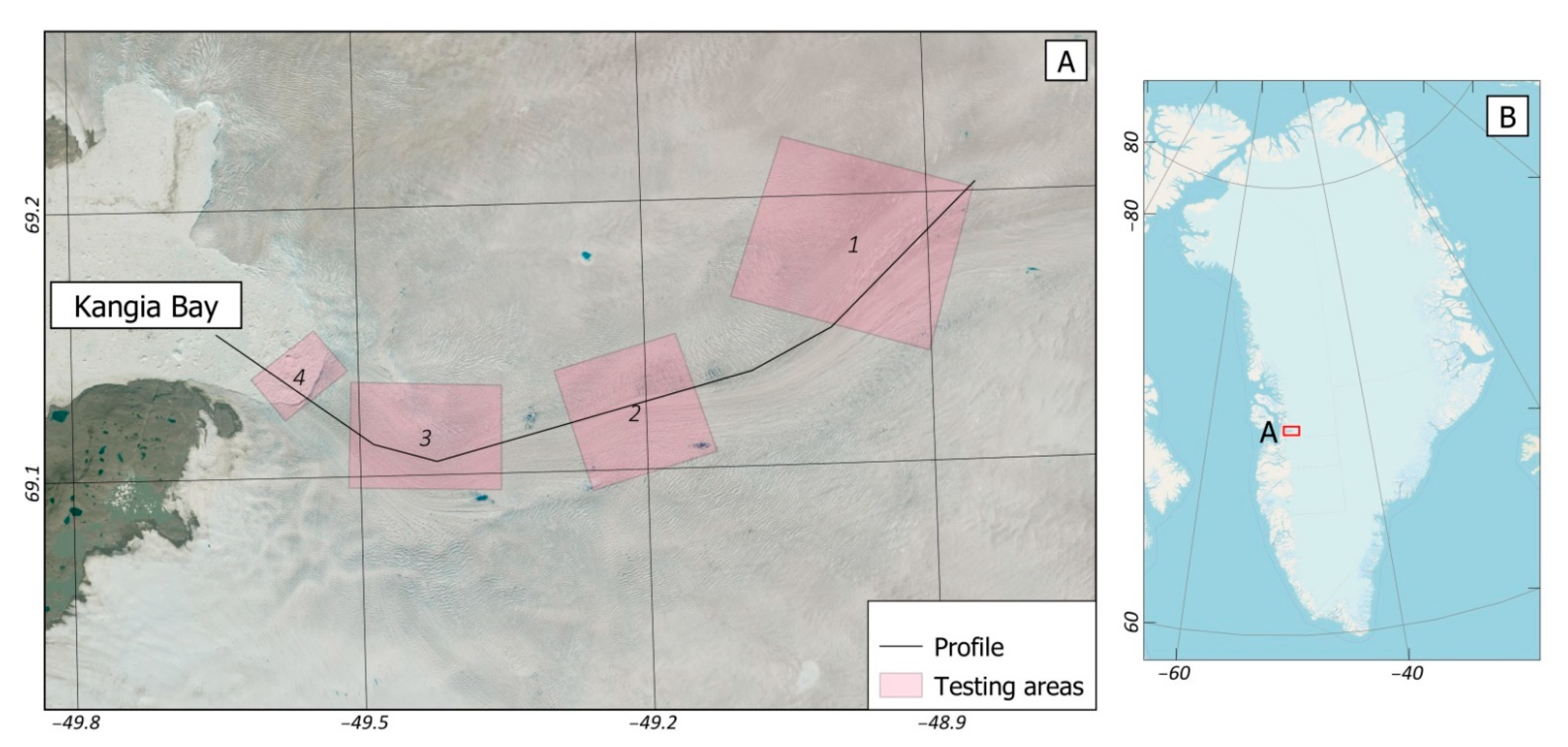

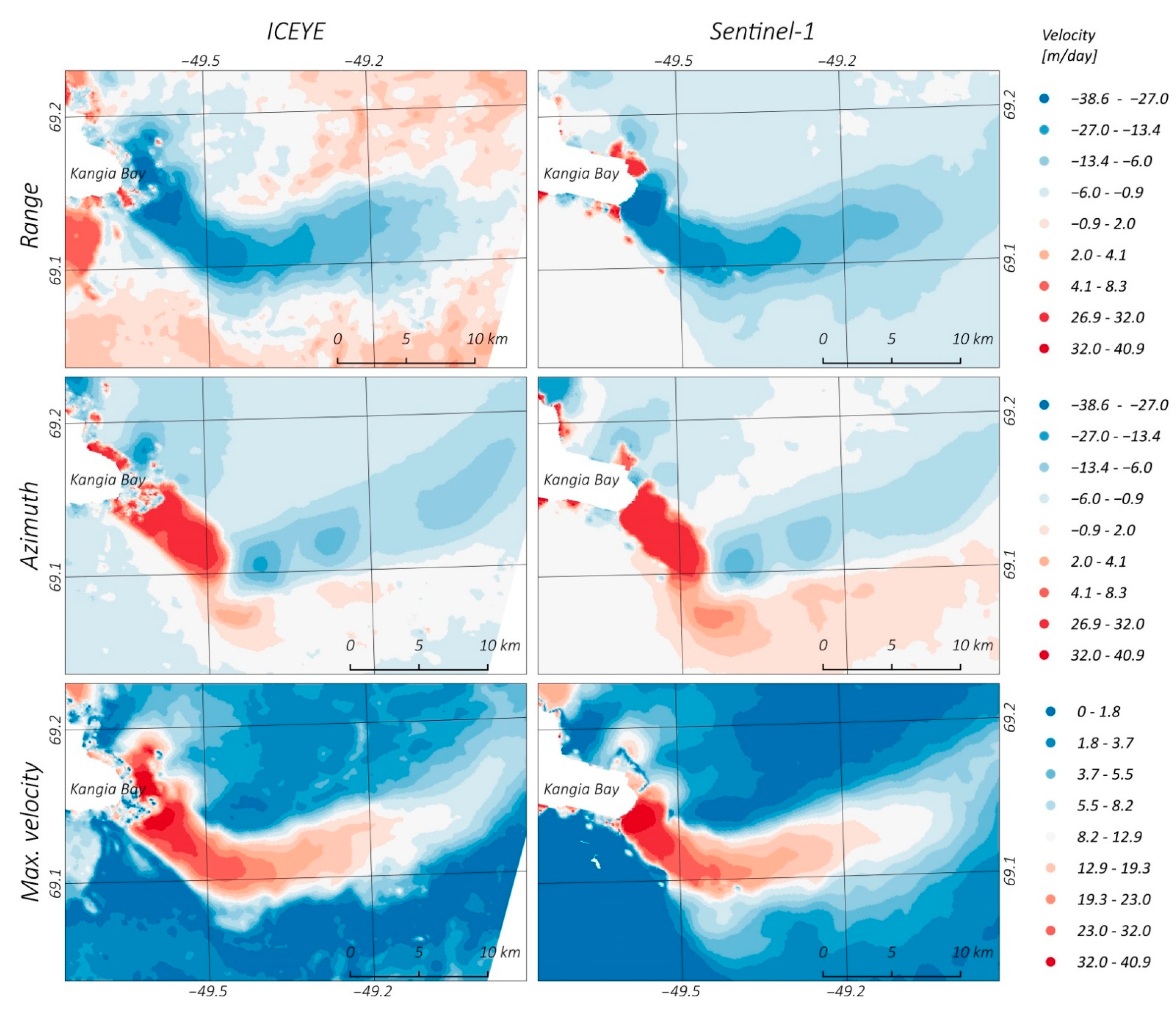
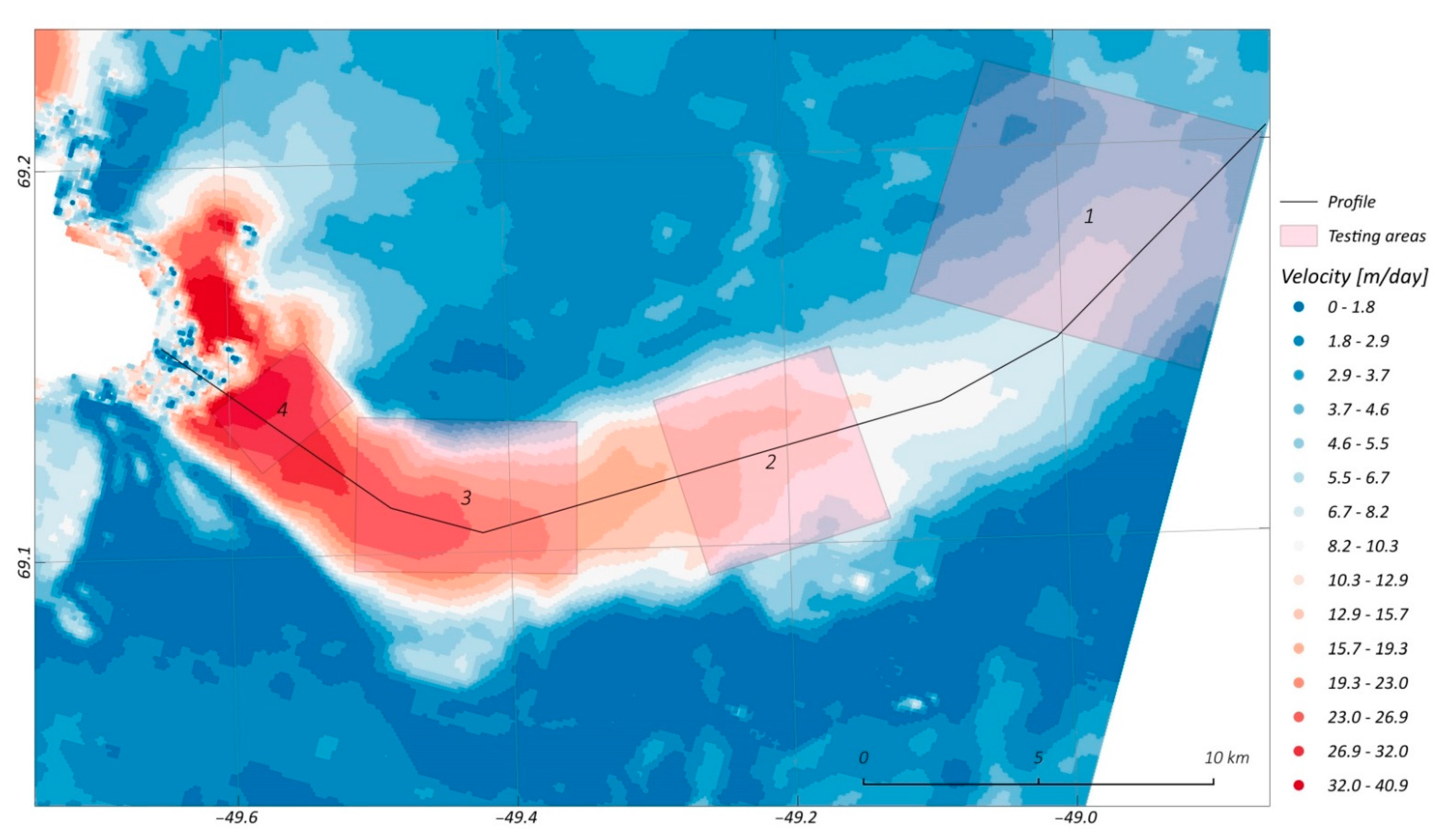
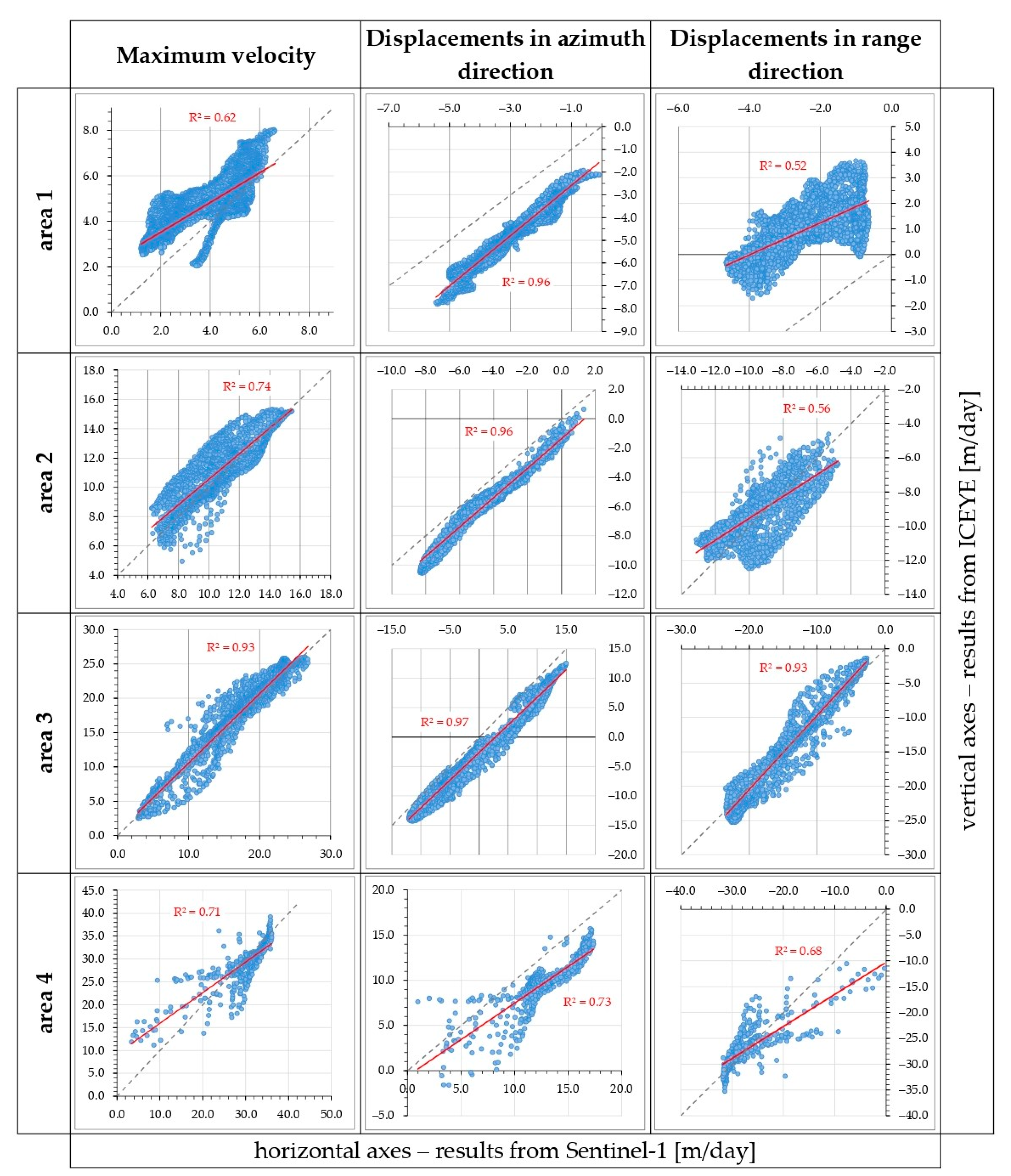

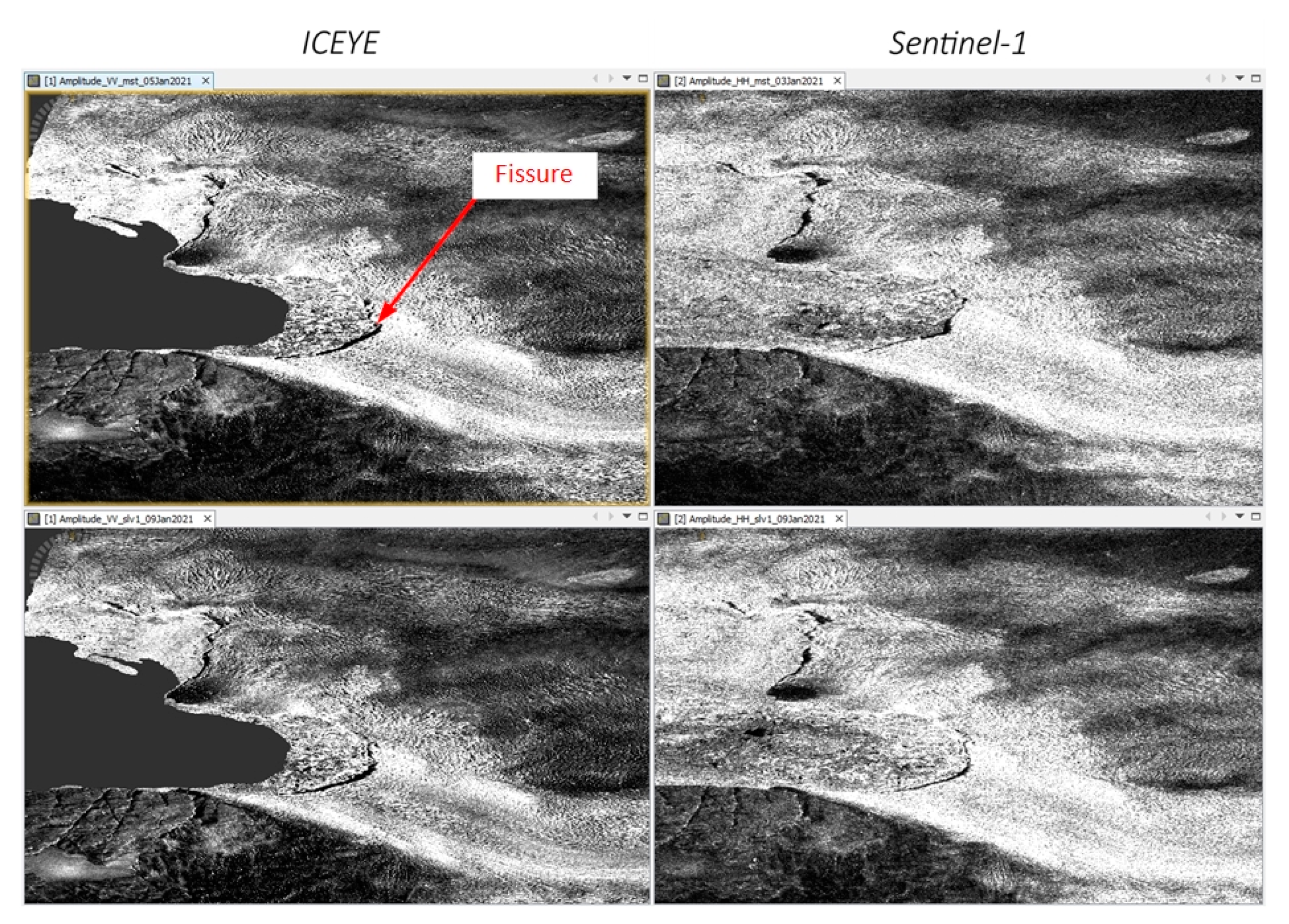
| Date | Sensor | Acquisition Mode | Incident Angle [°] | Heading [°] | Pixel Spacing | Swath Width | Polarization | Orbit Direction |
|---|---|---|---|---|---|---|---|---|
| 3 January | S-1A | Interferometric Wide | 30.3–45.6 | 203.7 | 10 × 10 m | 250 km | HH | desc |
| 5 January | X4 | Stripmap High | 26.9–30.1 | 196.5 | 2.5 × 2.5 m | 30 km | VV | desc |
| 9 January | S-1B | Interferometric Wide | 30.3–45.6 | 203.2 | 10 × 10 m | 250 km | HH | desc |
| 9 January | X7 | Stripmap High | 18.0–22.4 | 198.4 | 2.5 × 2.5 m | 30 km | VV | desc |
| Parameter | ICEYE | Sentinel-1 |
|---|---|---|
| Max velocity [m/day] | 50 | 50 |
| Registration window width [pxl] | 128 | 128 |
| Registration window height [pxl] | 128 | 128 |
| Grid azimuth spacing [pxl] | 40 | 10 |
| Grid range spacing [pxl] | 40 | 10 |
Publisher’s Note: MDPI stays neutral with regard to jurisdictional claims in published maps and institutional affiliations. |
© 2021 by the authors. Licensee MDPI, Basel, Switzerland. This article is an open access article distributed under the terms and conditions of the Creative Commons Attribution (CC BY) license (https://creativecommons.org/licenses/by/4.0/).
Share and Cite
Łukosz, M.A.; Hejmanowski, R.; Witkowski, W.T. Evaluation of ICEYE Microsatellites Sensor for Surface Motion Detection—Jakobshavn Glacier Case Study. Energies 2021, 14, 3424. https://doi.org/10.3390/en14123424
Łukosz MA, Hejmanowski R, Witkowski WT. Evaluation of ICEYE Microsatellites Sensor for Surface Motion Detection—Jakobshavn Glacier Case Study. Energies. 2021; 14(12):3424. https://doi.org/10.3390/en14123424
Chicago/Turabian StyleŁukosz, Magdalena A., Ryszard Hejmanowski, and Wojciech T. Witkowski. 2021. "Evaluation of ICEYE Microsatellites Sensor for Surface Motion Detection—Jakobshavn Glacier Case Study" Energies 14, no. 12: 3424. https://doi.org/10.3390/en14123424







